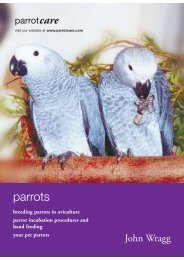incubation procedures and hand feeding - Parrotcare
incubation procedures and hand feeding - Parrotcare
incubation procedures and hand feeding - Parrotcare
Create successful ePaper yourself
Turn your PDF publications into a flip-book with our unique Google optimized e-Paper software.
parrotcare visit our website at www.parrotcare.com<br />
of approx. 100o F which will keep the eggs alive while<br />
the power is restored. Whilst this procedure is being<br />
followed take great care to ensure that eggs are not<br />
damaged. To reduce the overall vibration in the incubator<br />
cabinet it is advisable to have them situated on solid<br />
tables as low down to the floor as possible. It is amazing<br />
how easy it is to knock a table while passing <strong>and</strong><br />
subsequently destroying the eggs. Even small continuous<br />
vibrations on unstable surfaces can cause a reduction in<br />
hatchability. The floors in our <strong>incubation</strong> room are solid<br />
<strong>and</strong> the benches on which the incubators are placed are<br />
relatively low down which allows easy viewing of the<br />
eggs as well as reduction in vibration. The incubator<br />
which has been modified to use as a hatcher has<br />
merely had the bars removed <strong>and</strong> additional humidity<br />
can be applied to the egg by flooding the floor area.<br />
Cleanliness of incubators <strong>and</strong> hatchers is essential.<br />
At PARROTCARE we use a prepared diluted disinfectant<br />
which is ideal for this purpose. Whenever the incubator<br />
is empty disinfecting takes place before any new eggs<br />
are placed in it. Routine maintenance is also an area not<br />
to be neglected. If a motor begins to sound the worse for<br />
wear take the precaution of having sufficient spares to<br />
ensure the incubator will continue to function in the<br />
event of an emergency. The benefits of sticking with one<br />
type of incubator when purchasing a number of units is<br />
that spares <strong>and</strong> parts are interchangeable thus ensuring<br />
that in a crisis you can still maintain at least one or two<br />
incubators in working condition while the third is being<br />
repaired.<br />
The ambient temperature in the <strong>incubation</strong> room is<br />
critical <strong>and</strong> must be maintained at a stable level<br />
otherwise the equipment in the room will find it difficult if<br />
not impossible to maintain accurate temperatures. An<br />
example would be a room in which direct sunlight is able<br />
to penetrate <strong>and</strong> therefore cause wild fluctuations in the<br />
temperature. An ideal room for <strong>incubation</strong> purposes is a<br />
one without windows <strong>and</strong> protected from direct sunlight<br />
by another larger building. An example of an ideal<br />
<strong>incubation</strong> room would be a cellar or air conditioned<br />
room where the temperature could be maintained within<br />
a degree <strong>and</strong> therefore have the least temperature<br />
fluctuations that may affect the incubator. I have spoken<br />
to a number of parrot enthusiasts who believe their<br />
incubator is at fault due to its inability to maintain<br />
temperatures only when having a thorough discussion is<br />
it realised that the problem is not the incubator but the<br />
high fluctuations in ambient temperature in the room in<br />
which it is kept.<br />
Good cleanliness practices should be enforced in the<br />
h<strong>and</strong> rearing <strong>and</strong> <strong>incubation</strong> room. It is essential that<br />
viruses, fungus <strong>and</strong> other bacterial are not brought into<br />
the room by shoes <strong>and</strong> clothing which have been worn<br />
elsewhere. All equipment used in the <strong>incubation</strong> room<br />
should be disinfected <strong>and</strong> sanitised daily <strong>and</strong> all<br />
equipment which will come into direct contact with a<br />
chick or an egg should be sterilised after each<br />
procedure. The equipment I find indispensable in the<br />
<strong>incubation</strong> <strong>and</strong> h<strong>and</strong> rearing room are:<br />
tweezers small scissors torch<br />
HB pencil wound <strong>and</strong> skin cleaner cotton buds<br />
c<strong>and</strong>ler nail varnish, small microwave<br />
spotlight swivel chair on castors paper towels<br />
scales various sizes of needles infra red heat lamp<br />
cups spoons various sizes<br />
c<strong>and</strong>ling<br />
C<strong>and</strong>ling <strong>and</strong> repairing eggs is an important part of<br />
<strong>incubation</strong> procedure. As I have already mentioned,<br />
eggs should be c<strong>and</strong>led immediately after removal from<br />
the nest. By doing this, you become aware of any eggs<br />
which are dead in shell, clear <strong>and</strong> at what stage<br />
<strong>incubation</strong> has progressed. If you are unsure as to when<br />
the first egg is laid it is critical to identify an approximate<br />
age of the eggs at this stage <strong>and</strong> number the eggs in<br />
order of age. They are then placed in the incubator so<br />
that they can be visually identified in age. Any cracked<br />
eggs are made good at this point. As I have mentioned<br />
clear nail varnish has been used at PARROTCARE to<br />
good effect. A pair of Eleanora’s Cockatoos in our care<br />
break eggs routinely. Fortunately, these are usually<br />
hairline <strong>and</strong> if removed early enough <strong>and</strong> repaired the<br />
eggs will continue to progress <strong>and</strong> eventually hatch.<br />
Remember whenever varnish is placed on an egg that<br />
area will be less porous than the remainder of the egg<br />
<strong>and</strong> therefore if large areas are covered in varnish the<br />
chick is unable to reduce its water content at the necessary<br />
rate. Also if repairs have taken place over the area<br />
where the egg would normally pip <strong>and</strong> the chick rotate<br />
then an aided hatching will be required. Therefore any<br />
eggs that have been repaired cause a greater risk to



